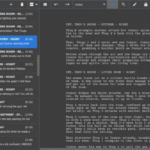As an author who’s been through the book-writing process many times, I’m excited to share my insights and strategies to help you bring your literary vision to life.
Writing a book is an incredible adventure that will challenge and inspire you in ways you never imagined. Here are the essential steps and techniques that will set you on the path to becoming a published author.
1. Nurture Your Idea
Every great book starts with a spark of inspiration. Your idea might be a character who won’t leave your thoughts, a world you’re eager to build, or a message you’re passionate about sharing.
Whatever form it takes, give it time to grow and develop in your mind.
I recommend keeping a notebook or digital file dedicated to your book idea. Jot down random thoughts, snippets of dialogue, or potential plot twists as they come to you.
This early stage is all about exploration and possibility, so don’t censor yourself.
Let your imagination run wild.
Consider creating a mood board or playlist that captures the essence of your book. These visual and auditory cues can help you stay connected to your idea and inspire you when you sit down to write.
2. Develop a Basic Structure
While some writers swear by detailed outlines, others prefer a more organic approach. I’ve found that a middle ground often works best, especially for first-time authors.
Create a basic structure for your book that gives you direction without stifling your creativity.
One effective method is the “snowflake technique” developed by Randy Ingermanson. Here’s how it works:
- Write a one-sentence summary of your book.
- Expand that sentence into a paragraph.
- Create a one-page summary for each main character.
- Expand your paragraph summary into a one-page plot synopsis.
- Write a detailed description of each major character.
- Expand your one-page plot synopsis into a four-page plot outline.
- Create character charts for each major character.
- Make a scene list.
This gradual expansion helps you develop your story naturally while maintaining a clear overall structure. Remember, this outline is a guide, not a rigid framework.
Be open to changes and new ideas as you write.
3. Establish a Writing Routine
Consistency is key when it comes to writing a book. Set aside dedicated time each day for writing, even if it’s just an hour.
Many successful authors, myself included, find that writing first thing in the morning works best.
The world is quiet, and your mind is fresh before the day’s distractions set in.
Create a writing space that inspires you. This could be a home office, a cozy corner of your living room, or even a local café.
The important thing is that it’s a space where you feel comfortable and focused.
Set realistic daily word count goals. I aim for 1,000 words per day, but your target might be different depending on your schedule and writing speed. The key is to make steady progress.
4. Focus on Getting Words on the Page
When you sit down to write, your primary goal should be to get words on the page. Don’t worry about perfection – that’s what editing is for.
As Ernest Hemingway famously said, “The first draft of anything is shit.” Embrace this mindset and give yourself permission to write imperfectly.
If you’re struggling with writer’s block, try these techniques:
- Start with a writing prompt
- Jump into a scene you’re excited about, even if it’s not the beginning of the book
- Use the “pomodoro technique” – write for 25 minutes, then take a 5-minute break
- Try freewriting – write without stopping for a set period, even if what you’re writing doesn’t make sense
Remember, you can always revise and improve your work later. The important thing is to build momentum and keep moving forward.
5. Develop Rich Characters
Characters are the heart of your story. Readers will connect with them more than any plot twist or clever prose.
Spend time developing your characters’ backgrounds, motivations, and voices.
Create detailed character profiles that include:
- Physical appearance
- Personality traits
- Backstory
- Goals and motivations
- Fears and weaknesses
- Relationships with other characters
Consider writing short scenes or vignettes about your characters’ pasts to help you understand them better. These may not make it into your final book, but they’ll inform your writing and make your characters feel more real.
Give each character a distinct voice. Pay attention to their speech patterns, vocabulary, and mannerisms.
This will make your dialogue more engaging and help readers distinguish between characters.
6. Craft a Vivid Setting
Whether you’re writing about a fantastical world or a small town in Ohio, your setting should feel vivid and real. Use all five senses in your descriptions to bring your world to life.
When describing your setting, consider:
- The physical landscape
- The climate and weather
- The culture and customs
- The history of the place
- The social and political structure
Don’t info-dump all of this information at once. Instead, weave it naturally into your story through your characters’ experiences and observations.
If you’re writing about a real place, do thorough research. Visit if possible, or use resources like Google Earth and travel blogs to get a feel for the location.
If you’re creating a fictional world, be consistent with your world-building details.
7. Overcome Writer’s Block
Every writer faces moments when the words don’t flow as easily. When this happens, don’t panic.
Writer’s block is a normal part of the creative process.
Here are some strategies to help you push through:
- Change your environment. Sometimes a new perspective can spark creativity.
- Go for a walk or exercise. Physical activity can help clear your mind.
- Read a book in your genre. This can inspire you and remind you why you love writing.
- Work on a different part of your book. If you’re stuck on a particular scene, move on to another section.
- Use writing prompts or exercises to get your creative juices flowing.
- Talk about your story with a friend or fellow writer. Sometimes verbalizing your ideas can help you work through problems.
Remember, writer’s block is temporary. Keep showing up, and the words will come.
8. Seek Feedback
As you progress, consider joining a writing group or finding beta readers. Fresh eyes on your work can provide valuable feedback and help you spot issues you might have missed.
When choosing beta readers, look for people who:
- Read regularly in your genre
- Will give honest, constructive criticism
- Can commit to reading your entire manuscript
- Understand that they’re reading a work in progress
Provide your beta readers with specific questions or areas you’d like them to focus on. This will help them give more targeted and useful feedback.
Be open to criticism, and trust your instincts. Not every suggestion will be right for your book, but consider each one carefully.
9. Edit and Revise
When you finish your first draft, take a moment to celebrate – you’ve accomplished something many people only dream of! But your work isn’t done yet.
Now comes the editing process.
Start with a big-picture edit, looking at:
- Overall structure and pacing
- Character arcs and development
- Plot consistency and logic
- Themes and message
Once you’re satisfied with the big picture, move on to line edits. This is where you polish your prose, tighten your language, and make sure every sentence serves a purpose.
Many writers find it helpful to take breaks between editing passes. This allows you to approach your work with fresh eyes.
Consider hiring a professional editor for a final polish. They can catch errors you might have missed and provide valuable insights to improve your book.
10. Choose Your Publishing Path
As you near the end of your writing journey, you’ll need to decide whether to pursue traditional publishing or self-publishing. Each path has it’s pros and cons.
Traditional publishing offers:
- Professional editing, design, and marketing support
- Wider distribution and potential for bookstore placement
- Prestige and validation
However, it also means:
- Less control over your book
- Lower royalties
- A potentially long and difficult process of finding an agent and publisher
Self-publishing offers:
- Complete creative control
- Higher royalties
- Faster time to market
But it also means:
- You’re responsible for all aspects of production and marketing
- Potentially lower sales and visibility
- Less prestige in some circles
Research both options thoroughly and choose the path that aligns best with your goals and circumstances.
11. Market Your Book
Regardless of your publishing path, you’ll need to be involved in marketing your book. Start building your author platform early:
- Create an author website
- Build a presence on social media
- Start a blog or newsletter
- Attend writing conferences and events
- Network with other authors and industry professionals
When your book is ready for release, consider:
- Hosting a launch party (virtual or in-person)
- Reaching out to book bloggers and reviewers
- Creating promotional materials like bookmarks or postcards
- Offering to speak at libraries or book clubs
- Running targeted ads on social media or Amazon
Remember, marketing is an ongoing process. Keep promoting your book long after it’s initial release.
Frequently Asked Questions
How long does it take to write a book?
The time it takes to write a book varies greatly depending on the author, the genre, and the length of the book. Some authors can finish a first draft in a few months, while others may take years.
On average, expect to spend 6-12 months writing your first draft, and another 3-6 months editing and revising.
How many words should my book be?
Word count varies by genre. Here are some general guidelines:
- Adult fiction: 70,000-100,000 words
- Young adult fiction: 50,000-80,000 words
- Middle grade fiction: 25,000-50,000 words
- Nonfiction: 50,000-75,000 words
Remember, these are just guidelines. Focus on telling your story well as opposed to hitting a specific word count.
Do I need an agent to get published?
If you’re pursuing traditional publishing with a major publisher, you’ll likely need an agent. However, some smaller publishers accept unagented submissions.
If you’re self-publishing, you don’t need an agent.
How much does it cost to self-publish a book?
The cost of self-publishing can vary widely depending on the services you use. At a least, you should budget for professional editing and cover design.
This can range from $1,000 to $5,000 or more.
Additional costs might include formatting, marketing, and printing if you’re doing physical copies.
How do I come up with a good book title?
A good book title should be memorable, relevant to your story, and appealing to your target audience. Brainstorm a list of potential titles, then ask for feedback from beta readers or fellow writers.
Consider titles that:
- Reflect the main theme or conflict of your book
- Use alliteration or rhyme for memorability
- Create intrigue or pose a question
How do I write a compelling opening chapter?
Your opening chapter should hook the reader and make them want to keep reading. Consider:
- Starting with action or conflict
- Introducing an intriguing character or situation
- Posing a question or mystery
- Using vivid, sensory language to draw the reader in
Avoid starting with lengthy exposition or background information. Instead, weave this information into the story as it progresses.
How do I know if my book idea is good enough?
There’s no goal measure of a “good” book idea. However, you can ask yourself:
- Does this idea excite you?
- Can you envision many scenes or plot points?
- Does it feel fresh or offer a new perspective on a familiar topic?
- Can you see yourself spending months or years working on this idea?
If you answer yes to these questions, your idea is likely worth pursuing.
How do I handle rejection from agents or publishers?
Rejection is a normal part of the publishing process. Even bestselling authors faced rejection early in their careers.
When you receive a rejection:
- Don’t take it personally
- Look for any constructive feedback in the rejection letter
- Keep submitting to other agents or publishers
- Consider revising your query letter or manuscript based on feedback
- Remember that publishing is subjective, and the right match is out there
Can I write a book if I’m not a native English speaker?
Absolutely! Many successful authors write in a language that’s not their first.
However, you may want to work with a native English-speaking editor to polish your manuscript before submission.
How do I stay motivated while writing a book?
Writing a book is a long process, and it’s normal to have ups and downs in motivation. Here are some strategies to stay motivated:
- Set small, achievable goals
- Reward yourself for meeting milestones
- Join a writing group for support and accountability
- Remember why you started writing in the first place
- Take breaks when needed, but maintain a consistent writing schedule
Key Takeaways
- Start with a solid idea and basic plan
- Establish a consistent writing routine
- Focus on getting words on the page, not perfection
- Develop rich characters and settings
- Don’t let writer’s block derail you
- Seek feedback from beta readers or writing groups
- Edit thoroughly, taking breaks between passes
- Choose your publishing path based on your goals
- Start building your author platform early
- Remember that writing a book is a marathon, not a sprint




